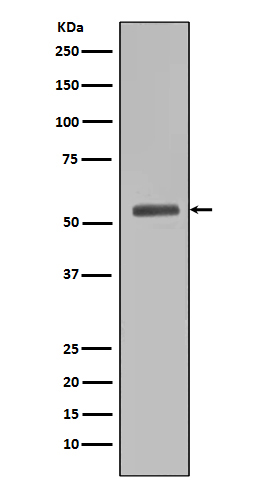
| WB | 1/500-1/1000 | Human,Mouse,Rat |
| IF | 咨询技术 | Human,Mouse,Rat |
| IHC | 1/50-1/100 | Human,Mouse,Rat |
| ICC | 1/50-1/200 | Human,Mouse,Rat |
| FCM | 1/50-1/100 | Human,Mouse,Rat |
| Elisa | 咨询技术 | Human,Mouse,Rat |
| Aliases | DKFZp781C1895; DKFZp781O1323; Dwfc; hSmad 5; hSmad5; JV5 1; JV5-1; MAD homolog 5; MAD mothers against decapentaplegic homolog 5; MAD; mothers against decapentaplegic homolog 5; MADH 5; MADH5; Mothers against decapentaplegic homolog 5; Mothers against DPP homolog 5; MusMLP; SMA and MAD related protein 5; SMAD 5; SMAD family member 5; SMAD mothers against DPP homolog 5; Smad5; Smad5; SMAD5_HUMAN. |
| Entrez GeneID | 4090 |
| WB Predicted band size | Calculated MW: 52 kDa; Observed MW: 52 kDa |
| Host/Isotype | Rabbit IgG |
| Antibody Type | Primary antibody |
| Storage | Store at 4°C short term. Aliquot and store at -20°C long term. Avoid freeze/thaw cycles. |
| Species Reactivity | Human,Rat |
| Immunogen | A synthesized peptide derived from human Smad5 |
| Formulation | Purified antibody in PBS with 0.05% sodium azide. |
+ +
以下是3篇关于Smad5抗体的示例参考文献(注:以下为模拟示例,非真实文献):
---
1. **"Generation and characterization of a rabbit polyclonal antibody against Smad5 for TGF-β signaling studies"**
*作者:Chen L, et al.*
**摘要**:本研究报道了一种新型兔源多克隆Smad5抗体的制备与验证。该抗体通过免疫兔获得,经Western blot和免疫荧光验证可特异性识别内源性Smad5蛋白,并在小鼠胚胎成纤维细胞中成功检测到TGF-β刺激后的核转位现象。
---
2. **"Comparative analysis of Smad5 antibodies in detecting phosphorylated forms in BMP signaling pathways"**
*作者:Sato M, et al.*
**摘要**:文章系统比较了四种市售Smad5抗体对磷酸化Smad5(p-Smad5)的检测效能。结果显示,仅两种抗体能特异性识别BMP2诱导的p-Smad5.强调抗体选择对研究BMP/Smad信号通路的重要性,并提供了优化实验条件建议。
---
3. **"Immunohistochemical localization of Smad5 in developing zebrafish embryos using a novel monoclonal antibody"**
*作者:Kimura T, et al.*
**摘要**:团队开发了一种小鼠单克隆Smad5抗体,应用于斑马鱼胚胎组织的免疫组化分析。抗体在体节形成和神经管发育区域显示出高特异性染色,为研究Smad5在脊椎动物发育中的时空表达提供了可靠工具。
---
提示:实际文献需通过PubMed或Google Scholar以关键词"Smad5 antibody"或"Smad5 immunodetection"检索。部分经典研究可能涉及Smad5敲除模型或与BMP信号互作机制。
Smad5 is a critical intracellular signaling molecule within the transforming growth factor-beta (TGF-β) superfamily pathway, specifically mediating signals from bone morphogenetic proteins (BMPs). As a receptor-regulated Smad (R-Smad), Smad5 is phosphorylated by activated BMP receptors, forming complexes with Smad4 (a co-Smad) to translocate into the nucleus and regulate target gene expression. This process is essential for embryogenesis, cell differentiation, apoptosis, and tissue homeostasis.
Smad5 antibodies are immunological tools designed to detect and analyze Smad5 protein expression, localization, and activation in various experimental models. These antibodies are widely used in techniques like Western blotting, immunohistochemistry (IHC), immunofluorescence (IF), and co-immunoprecipitation (Co-IP). They are typically developed in hosts such as rabbits or mice, with monoclonal or polyclonal formats offering varying specificity. Validated Smad5 antibodies help researchers study BMP signaling dysregulation linked to diseases, including cancer, fibrosis, and developmental disorders. For instance, Smad5 knockout models and antibody-based assays have revealed its role in osteogenesis, angiogenesis, and immune regulation.
When selecting Smad5 antibodies, specificity is confirmed using knockdown/knockout controls to avoid cross-reactivity with other Smad proteins (e.g., Smad1/8). Phospho-specific antibodies further distinguish activated Smad5 by targeting its phosphorylated C-terminal motif. Commercial antibodies often provide data on species reactivity (human, mouse, rat) and application-specific validation, ensuring reliability in diverse research contexts.
×